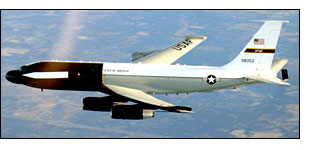KIRTLAND AIR FORCE BASE, N.M., March 23, 2006 -- Tests involving the airborne laser's beam control technologies, using a modified NKC-135E aircraft, are underway at an Air Force Research Laboratory (AFRL) hangar at Kirtland Air Force Base, N.M. Follow-up tests are set for later this month at the laboratory's facilities on White Sands Missile Range in southern New Mexico. 
A modified NKC-135E aircraft, with a white missile-shaped silhouette painted on its front section, prepares for a series of tests involving airborne laser beam control technologies.
These tests involve using low-power lasers to calibrate three special cameras mounted on the aircraft's port wing. The cameras record the laser energy as it hits a white, missile-shaped silhouette painted on the front section of the NKC-135E aircraft. From the data collected, scientists will be able to position and calibrate the cameras to properly collect information when the test aircraft becomes a "target board" for the airborne laser aircraft, or YAL-1A.
Later in the month, the cameras will be re-evaluated when the NKC-135E flies over White Sands Missile Range, the AFRL said. Scientists from the laboratory's Directed Energy Directorate, operating from North Oscura Peak facilities, will fire low-power lasers at the aircraft in follow-on tests under more realistic operational conditions. North Oscura Peak is an AFRL site managed by the directorate in the northern portion of the Army’s White Sands Missile Range, N.M. These lower-power lasers mimic the airborne laser's beacon illuminator laser, track illuminator laser and high-energy laser in wavelength, but not in power. The actual illuminator lasers are kilowatt-class; the high-energy laser is megawatt-class.
The NKC-135E is a highly modified Air Force aircraft derived from a Boeing 707 platform. This aircraft, called Big Crow, has been modified for electronic warfare-related work. In past years, the airborne laser program used a high-altitude aircraft called Proteus for some of the early laser targeting tests.
The Missile Defense Agency's airborne laser aircraft is undergoing final structural modifications at a Boeing facility in Wichita, Kansas. Once that work is complete, the illuminator lasers will be installed and ground-tested there. They will be fired into a receptacle called a range simulator, which will confine the beams and test the lasers' effectiveness, the AFRL said.
After ground testing, the illuminator lasers will be flight-tested aboard the airborne laser at White Sands. A low-power laser called a surrogate high-energy laser will substitute for the weapon's class chemical laser used by the YAL-1A. All three lasers will be fired at the silhouette on the NKC-135E, and their performance will be measured by the three cameras.
The high-energy laser, a chemical oxygen-iodine laser invented by Directed Energy Directorate scientists in 1977, is expected to be installed next year, the lab said, after the YAL-1A aircraft is moved to to Edwards Air Force Base, Calif.
For more information, visit: www.de.afrl.af.mil